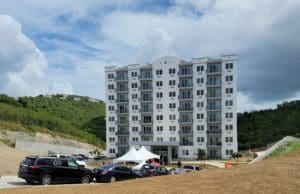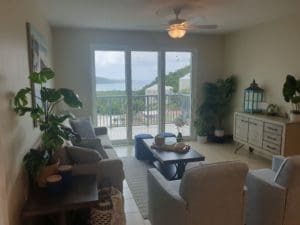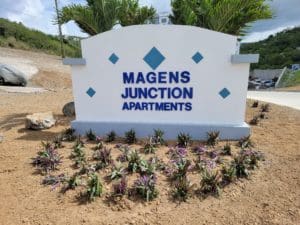
With affordable housing critically scarce in the U.S. Virgin Islands, especially on St. Thomas, the grand opening Wednesday morning of Magens Junction II, new low- to moderate-income apartments walking distance from Magens Bay beach, was cause for joy for Virgin Islanders of modest income.
Rev. Helen Mallieu-Maruros of the Wesley Methodist Church, in her invocation, called for Magens Junction Apartments to be a place where, “Couples, families, children and singles, all who call this place home, will be nurtured into wholesome and loving relationships.”
Three dozen government officials, money managers, developers and contractors who worked on the project sat under a couple of white canopies as Gov. Albert Bryan Jr. and others added their congratulations and dreams of continued development of similar public-private partnerships
With a total of 60 apartments, 30 one-bedroom, one-bath, and 30 two-bedroom, two-bath units, Magens Junction II is ready for occupancy. Its neighbor, Magens Junction Building I, is already home to dozens of residents.
Magens Junction includes a fitness center, library and community room. The nine-story structure is built to withstand major storms and is energy independent, using a microgrid supported by solar panels and other low emission energy sources along with battery storage. Each unit has a balcony.

Developer Robert Jackson, who was formerly a principal of Reliance Housing, is not new to such ribbon cuttings. Jackson, who eschews the limelight, has seen more than a half dozen such projects to completion on all three major islands. The Lovenlund Apartments, down the hill toward Magens Bay, had just such an opening celebration 18 years ago.
At a time when homeowners are evicting long-term tenants in order to turn scarce apartments into high-priced short-term vacation rentals, there is little or no room for young Virgin Islanders to get a foothold in the place they were born much less build wealth, which is tied to home ownership.
Add to that the exodus from large cities to the U.S Virgins when COVID-19 shuttered offices and executives learned they could work “at home” and home could be the U.S. Virgin Islands, which did not and could not close its borders like many other ex-pat favorites like Costa Rica, and you have a recipe for a housing shortage disaster for anyone but the wealthy.
And projects to provide housing for the low- to no-income sector have long met with even bigger roadblocks, especially opposition from neighbors.
On Wednesday, Carl Wise, managing director of investor relations for Hunt Capital Partners an equity investment firm that specializes in managing tax credit equity, harkened memories of Anna’s Hope on St. Croix, another Jackson Development Company affordable housing project. “No one wanted Anna’s Hope in their backyard,” Wise said. But it happened.
And that was true on St. Thomas and St. John as well.
The second right turn after Magens Junction is known as Peterborg. It is a peninsula sprinkled with sprawling villas that overlook Magens Bay on one side and offer an uninterrupted view of the Atlantic on the other. Peterborg is home to one of the first gated communities that popped up on St. Thomas. Another, Mahogany Run, which lies within earshot to the east of both Lovenlund and Magens Junction is also a gated community.
Residents of both communities protested the development of Lovenlund.
Calabash Boom on St. John, another Reliance project which actually offered home ownership to moderate-income Virgin Islands residents, also met with push back.
All of Jackson’s projects were eventually completed despite the dissatisfaction expressed by some community members.
Magens Junction was different.
Neighbors were not the problem this time. COVID-19 coupled with the aftermath of two back-to-back Category 5 hurricanes were the impediments this time, Jackson said in a brief conversation before the formalities began. “This project was hard.”
Bryan said the government, which worked alongside Jackson Development Corporation to fund the project using a combination of Low Income Housing Tax Credits and Community Development Block Grant – Disaster Recovery funding, was “investing in bringing people back.”

Robert Graham, executive director of the V.I. Housing Authority, was not in attendance Wednesday but has partnered with Jackson on numerous projects. For years, he said, he and Jackson were vying for the tax credits. “He always won.” So Graham and the developer agreed that Jackson would have the tax credits and half of the units would go to people being relocated from Tutu Housing Community, which was destroyed in the 2017 hurricanes or those on the Housing Choice waiting list, the program formerly known as Section 8.
“Of the 48 units in Magens Junction I, half are from Tutu,” Graham said in a phone conversation Wednesday afternoon.
But much more is needed. Graham said as of 2015, 5,000 low to medium-income units were needed. And despite the recent Census number which shows a substantial population loss seemingly as a result of the same hurricanes, he thinks the number of units needed could be as much as 9,000. Graham expressed strong confidence that those units would be built.
And to hear the governor and others speak Wednesday, he might have good reason to believe.
Bryan repeatedly spoke of the need for many more such developments to be completed by a public-private partnership. “I said to Darryl Griffith (Executive Director of the Housing Finance Authority). Let them do the work, and we’ll show up to cut the ribbon.”
On a more serious note, Bryan said, “We can’t grow the economy without housing,” adding “This has to be a paradise for Virgin Islanders, too.”


